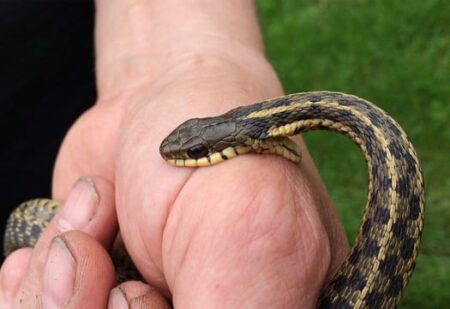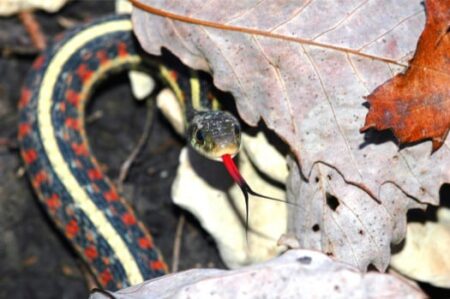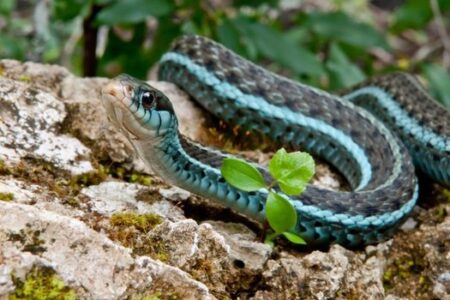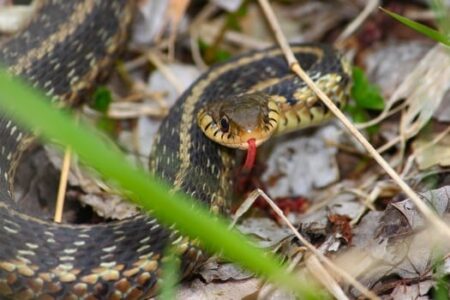Garter snakes are one of the easiest snakes to care for in captivity. Their calm temperament, small size, and harmless bite make them the ideal pet for any budding herpetologist.
Garter snakes are cold-blooded (ectothermic), so you’ll need a heat lamp or pad to regulate their body temperature. They need a meat-based diet to grow and thrive. Check periodically for health problems, such as worms, mites, blister disease, and gastrointestinal parasites.
Garter snakes will live for longer in captivity than they do in the wild if you meet their food and care needs. Many people are unsure of the types of food, heating, humidity, and the size of the vivarium that are needed. In this care sheet, we’ll cover how to look after a garter snake.
Why Are Garter Snakes Good Starter Pets?
Garter snakes are ideal for new snake owners because their care needs are limited. At the same time, they are fascinating creatures to behold. Here’s why garter snakes can make such great pets:
- Garter snakes are a ‘natricine’ species, so they don’t constrict their prey. As a result, they do not build up lots of thick muscle, so they’re thinner and smaller than many other snakes. This means that they’re easier to house and handle.
- The cost of setting up their tank and feeding them is quite low.
- They can be fed a wide variety of foods.
- Although they may become nervous in a new environment, garter snakes settle down after a couple of weeks, and their temperament can become very relaxed.
- Most subspecies of garter snake are diurnal (active during the day), so you can observe their activity at a convenient time.
- In the wild, garter snakes live for around 5 years. However, in captivity, they can live for 8-10 years.
Things to Know Before Getting a Garter Snake
It’s essential to be aware of the following points:
- They are low maintenance, but not zero maintenance. They often defecate so you’ll have to clean your snake’s cage regularly. Reptiles and amphibians spread germs and disease more readily than other pets. You will need to stay on top of the cleaning, especially if there’s anyone in the house with a weakened immune system.
- Although garter snakes rarely bite, they do musk (a foul smell).
- Garter snakes can get vitamin deficiencies if you don’t vary their diet.
If you’re prepared to clean the snake’s vivarium regularly, treat it well, and provide it with a nutritious diet, your snake will be calm and easy to handle. Your new snake will soon realize that it can trust you.
How to Identify a Garter Snake
Most garter snakes have stripes running lengthways down their body, mimicking the lines on a garter. Although these characteristic stripes can identify many types of garter snake, some subspecies have additional markings.

In addition to their markings, garter snakes have the following characteristics:
- Thin – most adult garter snakes are 1 inch in diameter
- A dark-colored body that is olive, brown, dark red, or black
- The stripes on the snake’s body are often yellow but could be white, orange, or tan
- The belly is pale green or yellow
- An adult grows to 18” – 26” on average (46 – 66cm)
- The average body mass is 150 g
- Keeled scales (ridged scales that are rough to the touch)
These features are all found in garter snakes, though do bear in mind that there are some differences within the species.
What Are The Types of Garter Snakes?
The garter snake (Thamnophis) can be found in most parts of North America. Some types are located in the colder regions of Alaska, whereas others are endemic to warmer southern states, like Florida. According to most sources, there are 34 different subspecies of garter snake.
So, are all garter snakes suitable for keeping as pets? Some subspecies have rarely been kept in captivity, so herpetoculturists haven’t had the chance to observe their behavior. The most popular garter snakes to keep as pets are:
- Common Garter Snake (Thamnophis Sirtalis)
- Checkered Garter Snake (Thamnophis Marcianus)
- Ribbon Snake (Thamnophis Sauritus)
These subspecies are known to have a relaxed temperament, feeding well, and thriving in captivity. So, if you’re a beginner, you’re better off opting for one of these snakes.
How to Identify a Common Garter Snake
The common garter snake is the one that’s most frequently encountered in the wild. It can cope with a wide range of temperatures so it can be spotted in most parts of America. It has the following physical characteristics:
- One narrow stripe running lengthways down the snake’s back with a thicker stripe on each side.
- Yellow stripes on a black, brown or greenish background.
Common Garter Snake (T. Sirtalis) vs. Ribbon Snake (T. Sauritus) Identification
Ribbon snakes look very similar to common garter snakes, but there are some differences:
- Ribbon snakes have a bold line separating the yellow side stripe from the belly. Common garter snakes do not have this bold line separating the back and the stomach.
- The ribbon snake has a longer tail than most other types of garter snake. The tail accounts for at least one-third of the entire length of the snake.
How to Identify a Checkered Garter Snake (T. Marcianus)
The checkered garter snake is favored for its calm temperament. Wild-caught checkered garter snakes often thrive in captivity because they can adapt quickly.
Checkered garter snakes rarely bite and can be easily handled, so they are one of the most popular garter snakes to keep as pets.
As you might expect, the snake has a checkerboard pattern on its body, but those characteristic lines and stripes are still visible, too. Often, checkered garter snakes have an olive-green back with light-colored stripes and a black checkerboard pattern.
Checkered garter snakes are sometimes mistaken for common garter snakes because some common garter snakes have very faint patterns of their back that resemble a checkerboard.
If the checkerboard pattern is light in color, this might suggest it is, in fact, a common garter snake rather than a checkered garter snake.
Are Garter Snakes Safe to Keep as Pets?
They are considered one of the safest snakes because they can be handled so easily. If your snake does feel threatened when you go to pick it up, it may respond in one of the following ways:
- It may flatten itself to the ground and get ready to strike or bite (uncommon)
- It may try to hide its head and thrash its tail
- It might release an unpleasant musky odor (and any feces it has available)

Garter snakes tend to musk or thrash their tail when they’re stressed. This behavioral response is quite common when they’re moved to a new environment.
Once your snake has settled in and has been handled a few times, it’s less likely to musk you.
Is a Garter Snake Poisonous?
Because garter snakes are non-threatening towards humans, people assume that they do not produce venom. Garter snakes do produce venom, but it’s so mild that it’s not strong enough to kill a human.
A garter snake’s venom is potent enough to subdue its prey (i.e. small amphibians), but nowhere near strong enough to do any damage to a human. The greatest risk from a garter snake bite would be the risk of infection if you didn’t clean the wound properly.
How Big Do Garter Snakes Grow?
Garter snakes give birth to live babies rather than eggs. The babies are approximately 15cm at birth and reach full size when they are about three years old. The average length of an adult garter snake is 46 – 66cm, though they can grow quite a lot bigger.
According to CBC, the record for the longest garter snake was 132cm. Male garter snakes are shorter and thinner than their female counterparts, so they don’t require as much tank space. So, if you’re short on space, you’d be better off opting for a male garter snake for this reason.
Where Can I Get a Garter Snake?
It’s advisable to get a captive-born baby garter snake, rather than a wild-caught adult. Snakes born in captivity are free of parasites and can tolerate being handled better because they’re introduced to humans from birth.
If you want to buy a garter snake, look for a local snake breeder in your area. Snake breeders sometimes advertise themselves on the notice-boards in pet stores or website directories.
According to the Center for Biological Diversity, it’s illegal to capture the San Francisco garter snake as it’s endangered.
If you intend to capture a wild garter snake yourself, you should check federal and state laws before doing so because this may not be legal, or you may need a license to do so. It’s not recommended.
Questions to Ask the Seller About The Snake
Ask your breeder questions before taking your snake home. This information will help you to understand your snake’s needs. Here are some critical questions to ask your breeder:
- What type of garter snake is this? If the subspecies are native to a particularly warm region, you may need to provide additional warmth or light in your vivarium. Also, if you’re planning to keep two snakes together in one cage, it’s advisable not to mix subspecies.
- When was this snake born? A garter snake will be fully grown by the time it is 3 years old. It’s useful to know the snake’s age so you can get the right size of the enclosure.
- Have you kept a record of its shedding? When snakes are going to shed their skin, they temporarily lose their appetite, so this information can help you understand your snake’s feeding behavior.
- Has this snake been handled often? Snakes that are used to handling are less anxious than those who rarely spend time around humans.
- What sex is this snake? Useful info for pairing snakes and breeding.
How to Check a Garter Snake for Health Problems
Perform a visual check for any garter snake health issues:
| Injury: | Check there are no protruding bones as this could indicate that there’s an injury. For example, a kinked spine. |
| Skin Problems: | Make sure that there are no visible blisters on the skin. |
| Parasites: | Check the snake is not wheezing or gasping for breath as it’s an indication of a parasite problem. |
| Lethargy: | If the snake is sluggish and doesn’t move around in your hands, this is a sign of illness or disease. |
| Mouth Issues: | If there is excess mucus in its mouth, then it may have a respiratory condition. If there are red bumps around the mouth or a cottage cheese-like substance in the mouth, this indicates that a snake has mouth rot. |
| Eyes: | The eyes should be clear and free of injury. However, if the snake is about to shed its skin, the eyes might be a bit cloudy. |
Housing a Pet Garter Snake
Garter snakes are notorious escape artists, so their enclosure needs to be very secure. The easiest way to accommodate your snake is to purchase an aquarium tank or reptile cage (vivarium) with a lockable lid.
Although a natural vivarium is considered beneficial for reptiles (i.e., containing soil and live plants), it is not practical for snakes that defecate as much as garter snakes do.
Garter snakes will be much easier to keep clean in a laboratory-style tank which has some well-chosen pieces of furniture and suitable substrate.
Choosing the Right Tank Size
It’s crucial for the enclosure to be big enough for your snake to move around, but not so big that it feels exposed and unsafe.
According to Science Direct, the perimeter of the base of the cage (the distance around it) should be at least double the length of your snake.
For example, a 12” x 8” cage has a perimeter of 40”. This means it could comfortably house a snake up to 20” long. This would be big enough to house a juvenile snake or perhaps a fully grown male, but not a fully grown female because females can grow to be 26” or more.
In terms of gallons, the following measurements are considered appropriate for garter snakes:
| Baby Snake: | 2.5-gallon tank |
| Adult male: | 10 or 15-gallon tank |
| Adult female: | 20-gallon tank |
Enrichment And Entertainment
Once you’ve got the correct size cage, you’ll need enrichment:
Hide Boxes
Provide your snake with at least one hide box (a small enclosure where your snake can hide). If you can offer your snake 2 hide boxes, then it’ll appreciate this. Hide boxes can be purchased cheaply.
You could also repurpose Tupperware, plant pots, or household items but make sure there are no sharp edges. Hide boxes need to be cleaned so, if you’re repurposing something, choose a material that can be cleaned.
Water Bowl
Your snake needs a water bowl. The water is essential not only for drinking but also for helping to snake to keep cool.
The bowl should be big enough for the snake to curl up in. Garter snakes should never be housed in aquatic or semi-aquatic tanks because they’ll quickly develop blisters on their scales.
Natural Furniture
Place a branch or rock in your vivarium to create places for your snake to hide and explore. It will also give the snake’s home a more authentic look.
Vivarium Substrate (Bedding)
Keep the base of your cage clean and dry to stop your snake from developing a blistered skin. The following are suitable bedding:
- Paper towels
- Newspaper pellets
- Aspen wood shavings
- Cypress Mulch
- Wood pulp (i.e. CareFresh bedding)
- Repti Bark
In the wild, garter snakes burrow to hide from predators and cool off. So, you need to choose the right type of substrate.

Avoid the Following Substrates
- Sand: Your snake might ingest it by accident, and this can lead to impaction (constipation).
- Cedarwood or Pine shavings: These smell too strong for a snake
- Corrugated card: The texture can make it difficult for the snake to move quickly so they might become stressed.
The substrate should be spot cleaned 2-3 times per week (as required) and replaced entirely every 3 weeks.
Cleaning a Vivarium
When cleaning your snake’s vivarium, follow these steps:
- Remove your snake to a second secure tank so you can clean the tank/vivarium thoroughly. Make sure it has a lid.
- Wear protective gloves (snakes carry salmonella)
- Empty everything from the tank and dispose of the substrate
- The furniture, food bowl, and tank should also be sterilized
- Once you’ve rinsed the tank, apply a pet-safe disinfectant
- Disinfect any cleaning equipment you’ve used, and get rid of any single-use items, such as DIY hides
- Wash your hands with antibacterial soap
- Once the tank is dry, put everything back inside
Keep a set of cleaning products specifically for this job. Do not wash the items in your kitchen to prevent cross-contamination.
Vivarium Temperature
Garter snakes are poikilothermic ectotherms. They rely on the external environment to help regulate their body temperature. This is why you see garter snakes basking themselves on rocks in the morning sun.
Because they use their environment to regulate their body temperature, they need to be able to warm up – and cool down – according to their needs. That’s why you need to create a temperature gradient in its vivarium.
Create a Temperature Gradient
Garter snakes need the temperature to be 25-30°C (80°F). It the temperature goes above 33°C (91°F), your snake will overheat.
The simplest way to create a temperate gradient is to place a reptile heating pad on the base of the cage and set it to a temperature of 84°F. The heat pad should cover no more than one-third of the cage.
You should aim for the cooler end of the cage to be around 70°F (21°C). This way, the snake can warm up, or cool down, depending on its needs.
Vivarium Lighting
Most garter snakes are diurnal (awake during the day), so having access to light during the day will help the snake to thrive.
Some owners believe that lighting is unnecessary. It’s true that many garter snakes could live healthy lives without additional lighting. However, in some cases, more lighting could make a positive difference:
- If you’re struggling to get the warmer side of your cage to 84 °F with a heat mat alone, and the ambient temperature of your room is less than 70°F, lighting can help you achieve extra warmth. A reptile basking light is your best choice as this will emit warmth.
- If the lighting in your room is very dim, a garter snake will benefit from extra lighting during the daytime. This could be achieved with an incandescent bulb or a reptile basking light.
- Black-neck garter snakes come from a hot climate, so they will appreciate the extra warmth and brightness.
- If you’re mating 2 snakes, install a reptile basking light. Several studies have shown that light encourages mating behavior.
Vivarium Humidity
Get a humidity gauge to monitor the humidity in the vivarium. You should aim for a humidity level of between 50% and 60%. You can achieve this most easily by using a humidifier.
If your snake becomes dehydrated, it will be unable to shed its skin effectively. Baby garters are prone to dry skin and dehydration.
If you have a garter snake that’s less than 1-year-old, provide a humid hide box for it. The easiest way to do this is to place some damp moss in the hide box. It’s a good idea to provide a dry hide box as well.
Snakes should always be provided with a bowl of cool, clean water that’s big enough for the snake to curl up in. As long as the water bowl is topped up, this will promote a good level of humidity in the tank.
What to Feed a Garter Snake
In the wild, garter snakes are opportunistic hunters, so they eat a very varied diet. According to Northern State University, they’ll consume grasshoppers, earthworms, frogs, toads, salamanders, small birds, rodents and other small mammals.
It would be hard to offer such a variety in captivity, but you should try to vary your snake’s diet. The following are suitable feeds that are quite easy to get your hands on:
- Earthworms and Nightcrawlers – These can be bought from fishing bait stores or harvested from your garden (as long as you don’t use pesticides on your soil). Worms should be cut into small pieces for baby garter snakes. While the common garter snake tends to eat these without fuss, a ribbon snake might not take to them as well.
- Frozen and thawed rodents – If you’re feeding a baby garter snake, start them off with pinky mice chopped into pieces.
- Frozen and thawed fish – Try to source salmon, trout, tilapia, or silverside. These fish do not contain thiaminase. If your snake is fed a diet rich in thiaminase, it can develop a vitamin deficiency.
Supplement your snake’s diet with calcium. Buy a calcium supplement that contains vitamin D because this will help metabolize the calcium.
Brush your snake’s food with a light coating of calcium powder once a month. Do not exceed this amount as a calcium overdose can be toxic.
Feeding Techniques
- Some snakes need to see their food moving to kickstart their appetite. Try dangling some food in front of your snake using tongs to see if this encourages your snake to eat. Don’t use your fingers.
- If you’re trying to introduce a new food, but you’re not having any success, try scenting the new food with the food that your snake is already accustomed to eating.
How Often do Garter Snakes Eat?
Juvenile garter snakes (0-2 years) should be fed once every 2-3 days, and adults can be fed once a week. It’s uncommon for snakes to overeat.
How Long Can Garter Snake Go Without Eating?
Garter snakes can go 2-3 months without eating, but this would be a red flag in captivity. When babies are first born, they won’t eat for about 10 days.
However, by this time, baby garter snakes should show some interest in food. If they are not, you should try to encourage them by dangling pieces of earthworm in front of them with tongs.

When a snake is about to shed its skin, it may lose its appetite for several days. However, if your garter snake has gone 2 weeks without eating, this is a red flag and should be investigated.
Reasons a Garter Snake Might Refuse Food
- Brumation. When winter arrives, it’s body may be preparing for brumation (hibernation), so your snake may refuse food.
- Stress. If you’ve caught an adult snake from the wild, and it has refused to eat for 2 weeks or more, it would be kinder to release it.
- Temperature. It’s too cold in the snake’s tank. Without an adequate temperature, snakes can’t digest their food.
- Food type. It may not like the food you are offering it.
Garter Snake Handling
Garter snakes often have calm temperaments, but they need to be handled appropriately. Here are a few handy tips:
- While your snake is learning to trust you, consider wearing gloves to protect your hands from bites. Although many garter snakes are tame, it is best to assume they are not until proved otherwise.
- When holding a garter snake in your hands, you’ll need to provide support to the snakes to prevent it from slipping through your fingers.
- Your garter may musk on you when you pick it up. This may happen many times while your snake gets acquainted with you. Clean any mess up to prevent the spread of bacteria.
- If you are bitten, and the snake won’t let go, gently push its head forward to disengage its jaw.
- If you are bitten, you should wash and dress the wound. Garter snake venom is not potent enough to harm humans.
Taking Care of Garter Snakes as Pets
- Food variety – garter snakes enjoy variety, so don’t feed them the same food all the time. A varied diet will prevent vitamin deficiencies.
- The perimeter of their tank – The base should be double the length of the snake to ensure that there’s enough room.
- Provide 2 hide boxes – This will encourage your garter snake to stay calm because it won’t feel overexposed. Put 1 at each end of the tank.
- Provide a temperature gradient – Snakes are cold-blooded. This will help your snake regulate its body temperature.
- A fresh supply of water – This must be available at all times.
- Keep things clean – Garter snakes frequently defecate, so be prepared to clean their tank each time this happens.
- Support your snake – When handling a garter snake, offer it adequate support so that it doesn’t slip through your fingers.
If you follow this advice, your garter snake will be calm and contented. It may even gravitate towards your hand when you go to pick it up.


Thank you so much for this thorough run-down! So very helpful!